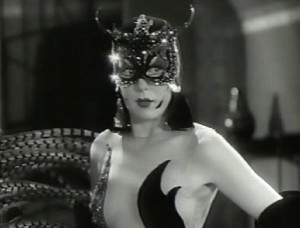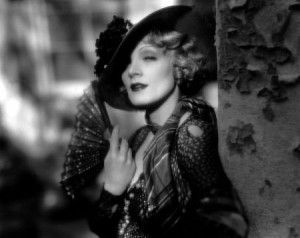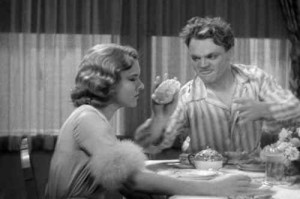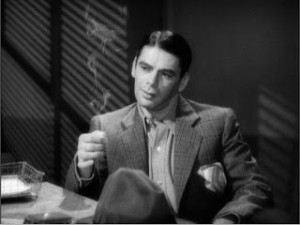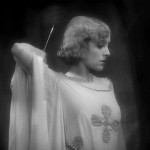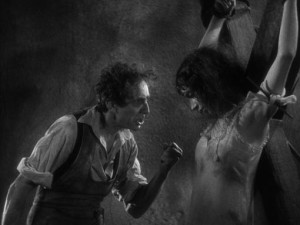Pre-Code Hollywood: Gangsters, Monsters, and Dames
I must have been about 12 years old when I first saw Tarzan and His Mate. I loved the Tarzan movies. Tarzan was the undisputed King of the Jungle and was the greatest, Cheetah was man’s best friend, Boy was annoying, and Jane was the Queen of the Jungle and a young male’s introduction to the allure of the female. The uncensored version, with a naked Jane silhouetted while changing clothes in a backlit tent and the spectacular underwater ballet scene would have been a revelation to me; Tarzan and Jane are frolicking in their favorite swimming hole, Tarzan in his usual loincloth and Jane naked – not naked from the waste up, or presumed naked as they hid her behind some lake flora or rocks – Jane was naked.
Most film fans knowledge of Pre-Code Hollywood movies doesn’t go much further than King Kong, Frankenstein, and a few other titles. These films are among the most remarkable to ever come out of Hollywood, made in a most unusual time. Prosperity had come to the U.S. after the Great War, large scale radio broadcasts which began in 1922 brought the Jazz Age to the world and clubbing was born. The excesses of the Roaring Twenties ushered in the decline of Victorian values, the stock market crash, and the Great Depression.
At the end of the silent era in 1930, the Production Code was adopted by the studios to appease those who wanted more censorship of the movies. Compliance was voluntary and the Code was ineffective as the studios had no intention of following it. The result was eccentric filmmaking with violence, nudity, drug use, extra-marital affairs, pre-marital sex, homosexuality, and a social conscience that commented on the Great Depression.
In 1934, the Production Code was finally enforced and would serve as Hollywood’s censor until 1968. The films referenced in this article, were all produced between 1930 and 1934 and are available on DVD or are in the public domain and can be seen online. You can also see clips from the films on YouTube.
I. Pre-Code Vice Films
The Pre-Code era was especially good for women who dominated the box office. Vice Films are about women behaving badly. The so called “fallen woman” and “bad girl” films have storylines depicting prostitution, drug use, sexual promiscuity, and marital infidelity. The titles were salacious – Laughing Sinners, The Road to Ruin, Free Love, Safe in Hell, and Eight Girls in a Boat – and the pictures distributed by the studios to fan magazines promoting these films were even smuttier with revealing photos that were nowhere to be found in the film posed for by models that weren’t either.
From the sensational novel Sanctuary by William Faulkner, The Story of Temple Drake is best known today as one of the films that finally brought about enforcement of the Code. Temple, the wild child of a well to do family, goes somewhere she shouldn’t, is raped by a local gangster and taken to a brothel to live. Her downward spiral ends when she murders her captor. A big time actress, Miriam Hopkins, played the part of Temple, but George Raft turned down the part of her gangster rapist calling the part “screen suicide.”
Other bad girls did better for themselves. In Baby Face, Barbara Stanwyck plays a young woman, Lil, who was raised in a speakeasy and pimped out by her father since she was 14-years-old. After her father is killed, she picks herself up and sets out for a better life taking with her the lesson of her hard, early life: if a woman is determined enough, she does have at least one thing going for her. A deadly combination of brains and brawn, Lil finds her way to New York and proceeds to climb the horizontal ladder to the top.
The bad girl uses sex for advancement and usually ends up unscathed after the dust has settled. Jean Harlow plays a scheming vixen that targets wealthy men in Red Headed Woman. And she’s pretty good at it. She marries conquest number one and when he doesn’t work his way to the top fast enough, she moves onto others, including his boss. Finally, she shoots her husband – who is having an affair of his own – then hightails it to Paris where she lands yet another rich sucker.
These films made little attempt to pass any moral judgment, instead they presented stories in a very honest way. Character flaws lead to bad choices for the fallen woman who pays heavily for her mistakes. In Three on a Match, three women reunite some years after their school days. Two are struggling to get by but one is married to a wealthy man and has a son. Seemingly the least likely to break bad, she hooks up with a man while on a cruise who takes her down the road to ruin. Divorce and drug addiction follow and only when her son is kidnapped and held for ransom by her new husband’s associates does her lost morality return – too late for her, however.
In Blonde Venus, Marlene Dietrich is a theater performer who meets an American student traveling in Germany, marries him, and moves to the States. When her husband has to leave home to seek a cure for a potentially terminal illness, she returns to the stage and has an affair with wealthy Nick Townsend (Cary Grant). Facing divorce when her husband returns, she scoops up their young son and hits the road. Staying one step ahead of the law, she supports her son by performing in cabarets and in the bedroom. In Waterloo Bridge, Mae Clarke plays a chorus girl who resorts to the world’s oldest profession to make ends meet in WWI-era London. A young soldier from a wealthy family, who thinks she’s a struggling stage performer, falls in love with her. But shame, remorse, and resignation won’t let her do what she wants to do – return his love and leave her sad life behind.
Others films worth watching: Night Nurse, Beauty For Sale, The Divorcee, A Free Soul, Call Her Savage, Female
II. Pre-Code Crime Films
Of more concern for the moral guardians of society were movies that not only had sex but were also violent and subversive: Gangster Films. The growing public dissatisfaction with big business, government officials, and the banks that wrecked the economy – along with their appreciation for bootleg whisky – gave gangsters an undeserved folk hero status. These movies were heavily scrutinized by the Hays Office, who cut more out of them than other film genres. Some have since been able to be reconstructed while others have lost footage.
A lot of The Public Enemy ended up on the cutting room floor, gone forever. James Cagney is Tom Powers, an Irish kid who grew up in pool halls and who thinks school is for saps. His ambitions drive him to become a powerful player in the lucrative bootleg trade. Tom proves to be the most ruthless in a mob war as a rival gang tries to take his boss’s territory. The violent nature of the relationship between men and women in gangland is played out as Tom keeps Gwen (Jean Harlow) on the side while enjoying Kitty (Mae Clarke) – who, in one of Hollywood’s great scenes, gets a grapefruit shoved in her face by Tom.
The ultra-violent Scarface was a takeoff on Al Capone and even borrowed his nickname for its title. Tony Camonti violently works his way up in the ranks to become top lieutenant for a crime boss. The boss tells him not to mess with the rival gangs but that goes against Tony’s nature. Tony is crude and makes pathetic attempts to be seen as sophisticated by dressing up and going to Broadway plays. The executions ordered by Tony are brutally depicted while more subtly portrayed is his too close relationship with his sister who dies with Tony during his last stand.
Little Caesar stars Edward G. Robinson as Rico, a low level criminal who believes in the American Dream: through hard work, anyone can make it. He works his way up, dethrones the boss, and becomes king of the syndicate. He doesn’t care about the money, booze or dames; he only wants to be on top. Boyhood friend and partner in crime Joe Massara (Douglas Fairbanks, Jr.), meets a girl and wants out, breaking gangster rule number one: once you’re in, you’re in, there is no getting out. Joe knows too much and Rico knows that for his own preservation he has to kill Joe. When he can’t pull the trigger on the only person he ever cared for, it’s the beginning of the end for Rico. His precipitous fall ends in a hail of bullets, but he’s already lost the only things that he cared about: power and respect.
Other films worth watching: Manhattan Melodrama, Quick Millions, The Last Parade, City Streets
III. Pre-Code Horror Films
Surprisingly, the Hayes Office had little to say about horror films. As long as the monsters didn’t have sex with anyone and were mum on religion and politics, pretty much anything went. Both Dracula and Frankenstein already had brand name recognition and were naturals for the first horror talkies. Many of the movies went the way of Frankenstein’s mad doctor: in Dr. X, a scientist commits murder and indulges in cannibalism in his attempt to develop synthetic flesh, Dr. Jekyll and Mr. Hyde showed us the evil that lies dormant in the human soul, and mad geneticist Dr. Moreau creates humans from animals in Island of Lost Souls.
Horror films were not the first choice of the movie going public who, caught up in the social chaos of the early 1930s, preferred lighter fare. But Dr. Jekyll and Mr. Hyde was really more a story of love, desire, and sexual repression as the Victorian Dr. Jekyll, frustrated by his fiancé’s continued postponement of their nuptials, mixes up a potion in the basement lab and unleashes his inner, evil self. The lecherous Mr. Hyde becomes an outlet for the Doctor’s lust as he pursues dance hall girl Ivy Pierson (Miriam Hopkins).
Another mad doctor, played by Bela Legosi, tortures and kills young women in Murders in the Rue Morgue. This one has nothing to do with love. The doctor’s experiments require “pure and untainted” blood, which he’s not getting from the prostitutes that his assistant brings him. He finds a “pure girl” and kidnaps her so he can inject her blood into a gorilla in a mad attempt to alter the species. The story so loosely follows Edgar Allan Poe’s original tale as to be almost unrecognizable.
Charles Laughton plays Dr. Moreau in Island of Lost Souls. The good doctor conducts experimental surgery on animals that turns them into human beings. Well, sort of. When shipwreck survivor Parker is brought to his island, Moreau sees the opportunity to mate him with his crowning achievement, the beautiful (and almost human) Panther Woman, Lota.
This film’s ending parallels Frankenstein as Moreau’s man-beasts march on the castle with torches in hand, killing the doctor and burning his House of Pain to the ground.
Other films worth watching: The Mystery of The Wax Museum, Freaks, The Invisible Man, White Zombie, The Mummy
Read the second part of this article:
“Pre-Code Hollywood 2: Music, Comedy, Action and Adventure”
Gregory Small
Latest posts by Gregory Small (see all)
- The Best B-Movies of the 21st Century - May 26, 2015
- From Vampires to Cave Girls: The History of Hammer Films - October 14, 2014
- Space Travel, Alien Invasions, and Atomic Monsters: The Best 1950s Science Fiction Films - June 11, 2014


